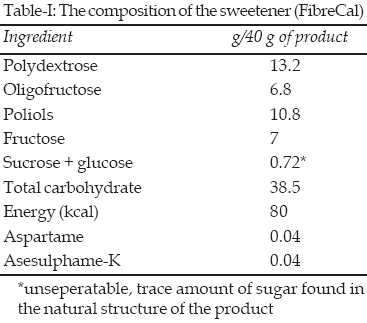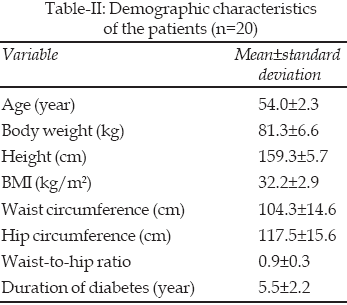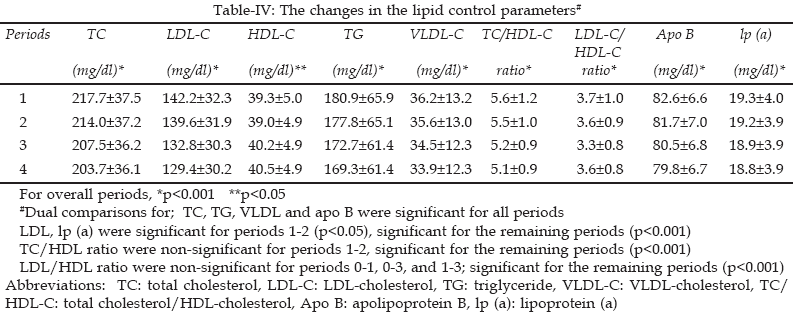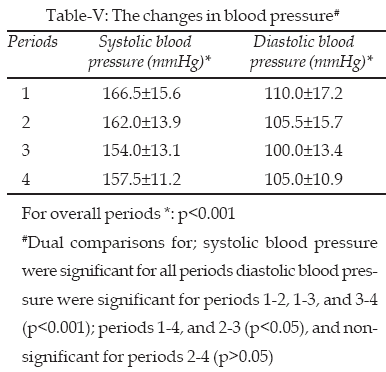|
|
||||
|
Published by : PROFESSIONAL MEDICAL PUBLICATIONS |
||||
|
ISSN 1681-715X |
||||
|
||||
|
- |
||||
|
ORIGINAL ARTICLE |
||||
|
- |
||||
|
Volume 25 |
July - September 2009 |
Number 4 |
||
|
|
||||
|
|
||||
|
|
||||
|
Published by : PROFESSIONAL MEDICAL PUBLICATIONS |
||||
|
ISSN 1681-715X |
||||
|
||||
|
- |
||||
|
ORIGINAL ARTICLE |
||||
|
- |
||||
|
Volume 25 |
July - September 2009 |
Number 4 |
||
|
|
||||
|
|
||||
The effects of oligofructose and polydextrose on
metabolic control parameters in Type-2 diabetes
Betul Cicek1, Perihan Arslan2, Fahrettin Kelestimur3
ABSTRACT
Objective: This study investigated the effects of oligofructose and polydextrose on metabolic control in Type-2 diabetes.
Methodology: Twenty voluntary, postmenopausal, total cholesterol (TC)/HDL-cholesterol (HDL-C) ratios >4.5, female, Type-2 diabetes patients were included. The study was performed in four periods, with the baseline as the period one. In periods two and four, the patients consumed individual diabetic diets for eight weeks. In period three, they consumed 20g of oligofructose and polydextrose mixture in 40g sweetener (in powdered form), added to their diets for six weeks.
Results: Prebiotic soluble fiber sources (oligofructose and polydextrose) significantly decreased fasting and postprandial (2-hour) blood glucose, glycosylated hemoglobin, TC, LDL-cholesterol (LDL-C), TC/HDL-C and LDL-C/HDL-C ratios, triglyceride, VLDL-cholesterol, lipoprotein (a), systolic and diastolic blood pressures (p<0.001), apolipoprotein B (p<0.05), and increased HDL-C, insulin (p<0.05), and C-peptide levels (p>0.05) compared to the initial values, respectively.
Conclusion: Individual diabetic diets supplemented with prebiotics improved metabolic control in Type-2 diabetes.
KEY WORDS: Diet, Type-2 diabetes, Nutrition, Oligofructose, Polydextrose, Prebiotics.
Pak J Med Sci July - September 2009 Vol. 25 No. 4 573-578
How to cite this article:
Cicek B, Arslan P, Kelestimur F. The effects oligofructose and polydextrose on metabolic control parameters in Type-2 diabetes. Pak J Med Sci 2009;25(4):573-578.
1. Betul Cicek, PhD,
Assist. Professor,
Department of Nutrition and Dietetics,
Erciyes University, Ataturk Health School,
Kayseri, Turkey.
2. Prof. Perihan Arslan, PhD
Department of Nutrition and Dietetics,
Faculty of Health Sciences, Hacettepe University,
Ankara, Turkey
3. Prof. Fahrettin Kelestimur, MD.,
Erciyes University, School of Medicine,
Department of Internal Medicine,
Division of Endocrinology and Metabolism,
Kayseri, Turkey.
Correspondence
Betul Cicek, PhD,
E-mail: betul.cicek@gmail.com
* Received for Publication: February 20, 2009
* Accepted: June 29, 2009
INTRODUCTION
Dietary intervention is one of the main therapies proposed to patients with Type-2 diabetes. The aim of the diet therapy is not only to decrease body weight but also to exert specific actions on the main abnormalities of Type-2 diabetes such as hyperglycemia, hyperlipidemia and insulin resistance. Dietary fibers of natural or synthetic origin have gained increasing attention because of their beneficial effects on decreasing blood glucose and lipids.
1Inulin and oligofructose are called as fructooligosaccharides and are natural food ingredients commonly found in >36000 plant species including wheat, onion, garlic, bananas, leek, asparagus, Jerusalem artichoke and chicory. The unique aspect of their structure is its b (21) bonds which prevent them being digested like a typical carbohydrate and are responsible for their reduced caloric value and dietary fiber effects.
2-7 Inulin and oligofructose are resistant to digestion in the upper gastrointestinal tract, they reach the large intestine intact, where they are fermented by indigenous bacteria and exert bifidogenic properties.2,8Polydextrose is a water soluble mixture of glucose, sorbitol and citric acid (approximate ratio 90:10:1). Because the 1-6 bond predominates in the polymer, polydextrose is resistant to hydrolysis by amylase, not absorbed in the intestine similarly with oligofructose and a large portion is excreted in the feces. Therefore, it is considered as a low-calorie bulking agent as dietary fiber.
9,10 In healthy Chinese subjects, the glycemic index of polydextrose was determined as 89 and ingestion of 12g/d polydextrose improved bowel function, increased fecal weight, decreased fecal pH.11Recent evidence has highlighted not only plasma Total Cholesterol (TC) but also plasma triglyceride (TG) as lipid risk factors for coronary heart disease. This has generated a lot of interest, since studies in rats have shown markedly reduced fasting TC and TG concentrations with diets containing significant amounts of oligofructose.
12-14 Fructooligosaccharides are non-digestible carbohydrates which are fermented by the gut microflora, in particular, bifidobacteria and lactobacilli. Previous work suggested that the mechanism of action of oligofructose was associated with the modulation of de novo cholesterol synthesis by short-chain fatty acids produced by the gut microflora during the fermentation process. Recent evidence has suggested that the TG-lowering effect of oligofructose occurs via reduction in VLDL-TG secretion from the liver as a result of the reduction in the activity of lipogenic enzymes and in the case of fatty acid synthase via modification of lipogenic gene expression.15In healthy subjects 20g/d fructooligosa-ccharide consumption for 4 weeks decreased basal hepatic glucose production but had no detectable effect on either Fasting Blood Glucose (FBG) and lipids or insulin-stimulated glucose metabolism.
16 In patients with Type-2 diabetes, consumption of fructooligosaccharides resulted in either unchanged,1,17 or lowered FBG and serum TC concentrations.18Thus, this study was performed to determine whether consumption of oligofructose and polydextrose could improve abnormal glucose, lipid concentrations and blood pressure in postmenopausal, female Type-2 diabetes patients.
METHODOLOGY
Subjects:
The study was conducted at the Outpatient Clinics of Endocrinology (Erciyes University) on twenty postmenopausal, TC/HDL-C ratios >4.5, voluntary female patients with Type-2 diabetes between March 2002 and June 2003. The mean ages were 54.0±2.3 years, Body Mass Index (BMI) 32.2±2.9 kg/m2, waist/hip ratios 0.9±0.3 and duration of diabetes 5.5±2.2 years, respectively. The women spend nearly 1/3 of their lives in postmenopausal phase. The morbidity and mortality risk of coronary heart disease are less for women at reproductive phase compared to men at the same age, but in postmenopausal phase the risk dramatically increases and the increment was reported to be three-four fold in diabetic females.19 Therefore, we recruited postmenopausal Type-2 diabetes patients for this study. All subjects gave written and verbal informed consent. This study was approved by the Ethics Committee of School of Medicine, University of Erciyes (Approval date and no: 16.04.2002, 02/128) and the procedures followed were in accordance with Helsinki Declaration.Experimental Design: This study was conducted for 14 weeks, consisting of four periods, baseline as the first period. In the second and fourth periods, the patients were given individual diabetic diets meeting all energy and nutrient requirements for eight weeks. In the third period, they consumed 20g of oligofructose and polydextrose mixture in 40g of sweetener added to their diets for six weeks. The patients consumed oligofructose and polydextrose mixture as sweetener in tea and herbal tea. The sweetener containing oligofructose and polydextrose was obtained from the manufacturer (Dalya Dora Foreign Trade, Istanbul, Turkey). The composition of the sweetener (FibreCal) was shown in Table 1. All the patients continued taking their oral antidiabetics during all periods of the study.
Anthropometric Measurements:
Body height and weight were measured using a calibrated scale. Height was measured to the nearest 0.5 cm and weight to the nearest 0.1 kg and BMI (kg/m2) was calculated. Waist and hip circumferences of subjects were measured twice to the nearest 0.5 cm and waist-to-hip ratios were calculated with the mean was used for subsequent analysis. Waist circumference was measured half way between the xiphisternum and the umblicus; hip circumference was measured at the level of the greater trochanters. Two consecutive measurements of blood pressure were taken on the right arm two-three minutes apart with the subject being seated at least 10 minutes by the nurse. Systolic blood pressure was first checked by palpation prior to the auscultatory measurements. Systolic and diastolic blood phase V pressures were recorded to the nearest two mmHg. Normal mercury sphigmomanometers (Boehringer-Mannheim, Germany) were used with standard sized cuffs. The average of the two blood pressures measured at 9.30 am and 15.30 pm was used for subsequent analysis.Sample Collection: Venous blood samples were collected after overnight fasting. Postprandial Blood Glucose (PPBG) was measured at two hours after breakfast. Blood samples were incubated for one hour at room temperature and sera were separated and stored at -20C until assayed.
Biochemical Analysis: Serum FBG and PPBG levels were determined by Mega Merck autoanalyzer (Finland) with glucose oxidase method. Serum TC, LDL-C, HDL-C, TG, VLDL-C levels were determined by Beckman Coulter, Syncron LX 20/LX20 pro, USA) with enzymatic reactions in Department of Biochemistry Laboratories. HbA
1c levels were determined using high performance liquid chromatography by Bio-Rad Variant (England) commercial kits. Insulin and C-peptide analysis were performed with BioSource (Belgium) commercial kits by immunoradiometric assay (IRMA) in Department of Nuclear Medicine Laboratories. Apo B and lp (a) analysis were performed by immunochemical assays with Sigma (Italy) commercial kits in Department of Biochemistry Laboratories.Statistical Analysis:
Data were expressed as mean±standard deviation (SD). Data were analyzed by SPSS 9.0 (Chicago, Illinois, USA) version for Windows. Repeated measures of variance analysis were used for determination of the difference between measurements prior to oligofructose and polydextrose supplementation and at the end of the study. Student’s t-test was used for dual comparison of the periods. The level of significance was set at 0.05 for overall statistical analyses.

RESULTS
The mean age, BMI and duration of diabetes were 54.0±2.3 years, 32.2±2.9kg/m
2 and 5.5±2.2 years, respectively (Table-II).

Oligofructose and polydextrose caused significant changes in the glucose control parameters (Table-III), lipid control parameters (Table-IV) and blood pressure (Table-V).

Oligofructose and polydextrose decreased FBG, PPBG and HbA1c levels (p<0.001) and increased insulin (p<0.05) and C-peptide levels (p>0.05). Also, TC, LDL-C, TG, VLDL-C, lp (a) levels, diastolic and systolic blood pressures, TC/HDL-C and LDL-C/HDL-C ratios (p<0.001) and apo B (p<0.05) significantly decreased and HDL-C significantly increased (p<0.05). Oligofructose and polydextrose consumption also significantly decreased the body weight and BMI of the patients (p<0.001).

It is known that polydextrose above 15g of intake may cause abdominal distention, abdominal cramps, diarrhea.8 In our study, although the consumed amount was close to 15g (13.2g/d) no gastrointestinal discomfort was reported by the patients. On the contrary, because of the self-reported chronic constipation problem, the patients reported ease of defecation by the consumption of oligofructose and polydextrose mixture.

DISCUSSION
To the best of our knowledge, this was the only study evaluating the effects of oligofructose and polydextrose together as a supplement in Type-2 diabetes patients with parameters regarding glucose and lipid metabolism and also blood pressure. In the literature the effects of oligofructose
1,13-18 was more focused on than polydextrose.11,20 So we speculate that the synergy between two prebiotic soluble fiber sources may improved glucose and lipid metabolism and blood pressure in Type-2 diabetes patients apart from the studies reporting no significant effects.In this study, consumption of 20g oligofructose and polydextrose mixture for 6 weeks reduced body weight and BMI significantly (p<0.001). Few studies have compared different fiber types and their association with body weight. In a longitudinal study, fiber intake was inversely associated with BMI.
21 On the other hand, the addition of dietary fiber to a low calorie diet significantly improved weight loss.22 When postmenopausal women consumed high fiber diets as a part of a study of very-low fat diets and weight loss, the high fiber diets were associated with significant weight loss.23Recent studies have shown the effects of serum TG to be due to reduced secretion of VLDL particles from the liver and to be associated with reduced activiy and gene expression of the key regulatory enzyme, fatty acid synthase.
24 Dramatic reductions in serum TG have been reported in rats consuming relatively high doses of oligofructose although reductions in cholesterol have been seen only with long-term feeding.In the previous studies investigating the effects of chronic consumption of fructooligosaccharides on plasma glucose and lipid concentrations gave divergent results in Type-2 diabetes patients.
1,17,18 Alles et al.17 found no major effects on glucose and lipids with consumption of 15g fructooligosac-charides for 20 days in Type-2 diabetes patients. Similarly, Luo et al.1 found no modifications in FBG and insulin concentrations or basal hepatic glucose production in Type-2 diabetes patients who were administered 20g/d fructooligosaccharides for four weeks. Inconsistent with these findings, Yamashita et al.18 demonstrated that daily intake of 8 g fructooligosaccharides for 14 days caused a significant decreases in FBG and serum TC levels in Type-2 diabetes patients. Furthermore it has been shown that the decreases in TC levels are mainly due to the reduction in LDL-C levels. Similarly, in the present study we detected significant decreases in FBG, PPBG and HbA1c (p<0.001) while insulin (p<0.05) and C-peptide levels increased (p>0.05) in Type-2 diabetes patients who consumed 20 g oligofructose and polydextrose for six weeks.Lipid abnormalities associated with diabetes are very important, because of the vulnerability of these patients to coronary heart diseases. Treatment of diabetes by low energy diets, oral hypoglycemic agents and insulin therapy frequently is not sufficient for perfect control of lipid metabolism. Several biological and epidemiologic studies have implicated lipid disorders and diabetes in the etiology of atherosclerosis and cardiovascular diseases.
14,25,26 In diabetic patients plasma lipid control was improved by diets rich in fibers.14,27,28 In this study TC, LDL-C, TG, VLDL-C, apolipoprotein B, lipoprotein (a) levels, diastolic and systolic blood pressures, TC/HDL-C and LDL-C/HDL-C ratios decreased, while HDL-C levels increased.In conclusion; individual diabetic diets supplemented with prebiotic soluble fiber sources (oligofructose and polydextrose) may improve glycemic and lipidemic parameters of metabolic control as well as hypertension in Type-2 diabetes patients, without any side effects. Further multi-center studies with a large sample size are needed to elucidate the exact mechanism.
REFERENCES
1. Luo J, Yperselle V, Rizkalla W, Rossi F, Bornet F, Slama G. Chronic consumption of short-chain fructooligosaccharides does not affect basal hepatic glucose production or insulin resistance in type 2 diabetics. J Nutr 2000;130:1572-7.
2. Ninesse K. Inulin and oligofructose: what are they? J Nutr 1999;129 suppl:1402S-6S.
3. Roberfroid M. Dietary fiber, inulin and oligofructose: a review comparing their physiological effects. Crit Rev Food Sci Nutr 1993; 33:103-48.
4. RoberfroidM, Delzenne N. Dietary fructans. Annu Rev Nutr 1998;18:117-43.
5. Setser C, Racette W. Macromolecule replacers in food products. Crit Rev Food Sci Nutr 1992;32:275-97.
6. Roberfroid M. Fructooligosaccharides. Crit Rev Food Sci Nutr 1999;39:267-74.
7. Roberfroid M, Loo V, Gibson R. The bifidogenic nature of chicory inulin and its hydrolysis products. J Nutr 1998;128:11-19.
8. Davidson M, Maki C. Effects of dietary inulin on serum lipids. J Nutr 1999;129 suppl:S1471-3.
9. Craig S, Troup H, Averbach M, Frier H. Polydextrose as soluble fiber: physiological and analytical aspects. Cereal Foods World 1998;43:370-6.
10. Anon. Litesse US Fiber Labeling Status of Polydextrose, 2001.
11. Jie Z, Bang-Yao L, Ming-Jie X, Hai-Wei L, Zu-Kang Z, Ting-Song W et al. Studies on the effects of polydextrose intake on physiologic functions in Chinese people. Am J Clin Nutr 2000;72:1503-9.
12. Kok N, Roberfroid M, Robert A. Involvement of lipogenesis in the lower VLDL secretion induced by oligofructose in rats. Br J Nutr 1996;76:881-90.
13. Kok N, Morgan L, Williams C, Roberfroid M, Thissen J, Delzenne N. Insulin, glucagon-like peptide-1, glucose dependent insulinotropic polypeptide and insulin-like growth factor 1 as putative mediators of the hypolipidemic effect of oligofructose in rats. J Nutr 1998;128:1099-1103.
14. Agheli N, Kabir M, Berni-Canani S, Petitjean E, Boussairi A, Luo J, et al. Plasma lipids and fatty acid synthase activity are regulated by short-chain fructooligosaccharides in sucrose-fed insulin resistant rats. J Nutr 1998;128:1283-8.
15. Jackson K, Taylor G, Clohessy A, Williams C. The effect of daily intake of inulin on fasting lipid, insulin and glucose concentrations in middle-aged men and women. Br J Nutr 1998;82:23-30.
16. Luo J, Rizkalla S, Alamowitch C, Boussairi A, Blayo A, Barry J, et al. Chronic consumption of short-chain fructooligosaccharides by healthy subjects decreased basal hepatic glucose production but had no effect on insulin-stimulated glucose metabolism. Am J Clin Nutr 1996;63:939-45.
17. Alles M, de Roos N, Bakx C, van den Lisdonk E, Zock L, Hautvast J. Consumption of fructooligosaccharides does not favorably affect blood glucose and serum lipid concentrations in patients with type 2 diabetes. Am J Clin Nutr 1999;69:64-9.
18. Yamashita K, Kawai K, Hakura M. Effects of fructooligosaccharides on blood glucose and serum lipids in diabetic patients. Nutr Res 1984;4:961-6.
19. Serin S. Effects of continuous versus cyclical transdermal oestrogen replacement therapy on blood lipid, lipoprotein and nitric oxide levels. Erciyes University, School of Medicine, Department of Gynecology and Obstetrics, Thesis of Specialty, Kayseri, 1999.
20. Bamba T, Fuse K, Chun W, Hosoda S. Polydextrose and activities of brush border membrane enzymes of small intestine in rats and glucose absorption in humans. Nutrition 1993;9:233-6.
21. Ludwig D, Pereira M, Kroenke C, Hinler J, van Horn L, Slattery M. Dietary fiber, weight gain and cardiovascular risk factors in young adults. JAMA 1999;282:1539-42.
22. Birketvedt G, Aaseth J, Fiorholmen J, Ryttig K. Long-term effect of fibre-supplement and reduced energy intake on body weight and blood lipids in overweight subjects. Acta Med 2000;43:129-32.
23. Mueller-Cunningham M, Quintana R, Kasim-Karakas S. An ad libitum very low-fat diet results in weight loss and changes in nutrient intakes in postmenopausal women. J Am Diet Assoc 2003;103:1600-6.
24. Williams C. Effects of inulin on lipid parameters in humans. J Nutr 1999;129 suppl:S1471-3.
25. Carlson LA, Bottinger LE. Risk factors for ischaemic heart disease in men and women, results of the 19-year follow up of the Stockholm Prospective Study. Acta Med Scand 1985;218:207-11.
26. Stamler J, Vaccaro O, Neaton J, Wenworth D. Diabetes and other risk factors and 12-year cardiovascular mortality in men screened in the Multiple Risk Factor Intervention Trial. Diabetes Care 1993;16:434-44.
27. Riccardi G, Rivellese A, Paccioni D, Genovese S, Mastranzo P, Mancini M. Separate influence of dietary carbohydrate and fiber on the metabolic control in diabetes. Diabetologia 1984;26:116-21.
28. Rivellese A, Riccardi G, Giacco A, Paccioni D, Genovese S, Mattioli P, et al. Effect of dietary fiber on glucose control and serum lipoproteins in diabetic patients. Lancet 1980;8192:447-50.
HOME | SEARCH | CURRENT ISSUE | PAST ISSUES
Professional
Medical Publications
Room No. 522, 5th Floor, Panorama Centre
Building No. 2, P.O. Box 8766, Saddar, Karachi - Pakistan.
Phones : 5688791, 5689285 Fax : 5689860
pjms@pjms.com.pk